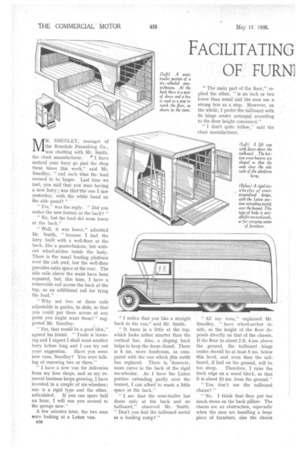FACILITATING THE LOADING OF FURN1 TURE VANS
Page 54

Page 55

If you've noticed an error in this article please click here to report it so we can fix it.
MR. SMEDLEY, manager of the Rosedale Furnishing Co., was chatting with Mr. Smith, the chair manufacturer. 4 I have noticed your lorry go past the shop three times this week," said Mr.
Smedley, "and each tithe the load seemed to be larger. • Last time we met, you said that you were having a new lorry ; was that the-one I saw yesterday, with the white band on the side panel? "
"Yes," was the reply. "Did you notice the new feature at the back? "
" No, but the load did seem lower at the back."
• " Well, it was lower," admitted Mr. Smith, "because I had the lorry built with a well-floor at the back, like a pantechnicon, but without wheel-arches inside the body.
There is the usual loading platform over the cab roof, but the well-floor provides extra space at the rear. The side rails above the waist have been repeated, but, this time, I have a removable rail across the back at the top, as an additional rail for tying the load."
"Why not two or three rails adjustable in guides, to slide, so that
you could put them across at any point you might want them?" suggested Mr. Smedley.
" Yes, that would be a good idea," agreed his friend. "Trade is boom ing and I expect I shall want another lorry before long and I can try out your suggestion. Have you some new vans, Smedley? You were talking of renewing two or three."
" I have a new van for deliveries from my four shops, and as my re moval business keeps growing, I have invested in a couple, of six-wheelers ; one is a rigid type and the other, articulated. If you can spare half an hour, I will run you around to the garage now."
A few minutes later, the two men were looking at a Luton van. B96
I notice that you like a straight back to the van," said Mr. Smith.
" It leans in a little at the top, which looks rather smarter than the vertical line. Also, a sloping back helps to keep the doors closed. There is 6 ins, more headroom, as compared with the van which )this outfit has replaced. There is, however, more curve in the back of the rigid six-wheeler. As I have the Luton portion extending partly over the bonnet, I can afford to waste a little space at the back."
" I see that the semi-trailer has doors only at the back and no tailboard," observed Mr. Smith. "Don't you find the tailboard useful as a loading ramp?" "All my vans," explained Mr. Smedley, "have wheel-arches inside, so the height of the floor depends directly on that of the chassis. If the floor be about 2 ft. 4 ins, above the ground, the tailboard .hinge centre should be at least 8 ins, below this level, and even then the tail-. board, if laid on the ground, will be too steep. Therefore, I raise the back edge on a wood block, so that it is about 10 ins, from the ground."
"You don't use the tailboard chains? "
"No. I think that they put too much stress on the back pillars. The chains are an obstruction, especially when the men are handling a large piece of furniture, also the chains
prevent an approach to the tailboard from the side. When the van has a well-floor, the front edge of the open tailboard can • be level with the floor, but it will be about the same height above the ground as in the lastnamed instance. The well-floor avoids the step between the tailboard and the van floor, although there is a step inside, which is absent with the normal type of floor."
'Why not have a step between the tailboard and the van when you have a well-floor? Then the loading ramp would be almost flat," suggested Mr. Smith.
"Yes, I have seen that kind of tailboard, with a hinge centre below the bottom of the body. When the tailboard is open it may have a moderate slope and rest on the ground, or with blocks it may be practically horizontal. The main idea is to make the best use of a moderate size of tailboard, so as to take up the least possible amount of roadway -.when unloading by the kerb."
As the two men came out of the garage, a platform lorry (carrying a container), which was drawing a four-wheeled trailer also carrying a lift van, had pulled up close by.
" No fancy lines here," commented Mr. Smith, pointing to one of the vans. "Do they standardize the lift vans and platforms, so that one always fits the other? "
" Well," replied Mr. Smedley, " it should not be necessary for the lift van to fit between the side rails of the platform. The main portion of the cross-bearers of the van is deeper than at the ends, so that the ends may clear the side rails."
"You can't use the tailboard of the lift van as a loading ramp," observed Mr. Smith.
"No, it's too high from the ground, although matters are improved if the platform lorry has small wheels. Perhaps, in the future, the container will have wheels mounted on stub axles secured to the sides of the body, like a horsebox trailer I saw the other day. Then, with a winch and a pair of planks hooked on to the back of the platform, the lift van could be lowered to the ground."




































































































